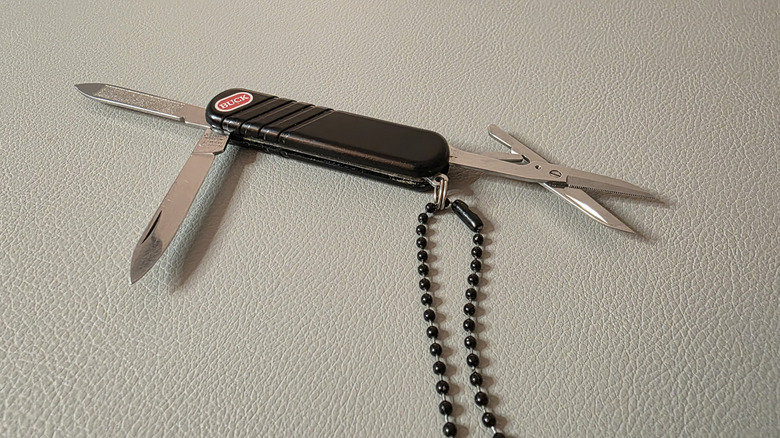Not Sure Which Swiss Army Knife You Have? Here's How To Identify It
Few common items are as durable as the trusty Swiss Army Knife, which has been a staple of the daily carry for over a century. Consequently, there are a lot of them floating around in the world, and it's not uncommon to come into possession of one without its original packaging intact. If the knife ever needs repairs, or if you want it appraised as a collector's item, you'll need to know the make and model. Identifying your knife can feel like a daunting task, especially given that there have been hundreds of different Swiss Army Knives released over the years. Whether you were gifted your multitool, bought it at a pawn shop, or if it fell out of the sky, how can you tell what kind of Swiss Army Knife you have?
Thankfully, genuine Swiss Army Knives are incredibly distinct, and it's easy to match yours to its model with a bit of examination. Swiss Army Knife brands Wenger and Victorinox were the only brands to manufacture the iconic multitools until Victorinox bought its competitor, which narrowed down the pool of possibilities quite a bit. Unfortunately, Swiss Army Knife alternatives are often much less well documented. You can narrow your options down further by paying close attention to a variety of identifiers including size, included tools, logos, and stampings on the blade. With a few key identifiers and a bit of sleuthing, most Swiss Army Knives can be identified in a matter of minutes. So, here's how to identify yours.
Physical characteristics of a Swiss Army Knife can help identify it
To deduce which Swiss Army Knife you have, carefully measure it lengthwise, take note of which tools it has, what the logo on its casing looks like, as well as its color (not all Swiss Army Knives are red), and any other distinctive markings. All of this information can help you whittle down the incredible number of Swiss Army Knife models in circulation.
Measure the casing of your Swiss Army Knife lengthwise in millimeters, as length is a crucial differentiator between similar models of multitool. For example, the SwissBuck series made by Wenger in collaboration with Buck during the 1990s contained both the SwissBuck Legend and SwissBuck PocketMate. The two were identical aside from the length, with the Legend measuring 65 millimeters and the PocketMate measuring 75.
The casing can also help you identify your Swiss knife. Continuing with the same example, the Legend was only differentiated from the much more popular Wenger Esquire by its casing, with the former sporting a black or white ribbed casing with the Buck logo while the latter was clad in classic Wenger red with the squircle-shaped Wenger logo. Speaking of logos, the now-defunct Wenger used the aforementioned squircle, while the still-operational Victorinox uses a shield shape. Both have a symbol shaped like a plus sign inside the insignia.
Lastly, tang stamps printed at the base of the primary blade of the multitool can also help you identify it. These are engravings that denote the era of manufacturing from 1983 to the present day. For example, Victorinox Swiss Army Knives made between 2011 and the time of this writing have a stamp reading, "Victorinox Swiss made stainless," on one side of the blade, and, "Officier suisse," on the other side.
Use the identifiers on your Swiss Army Knife to locate your model online
Once you've gathered everything you can from physically examining your Swiss Army Knife, use those identifiers to locate your particular model in online databases. There are a couple of ways to do this. Databases like SAKWiki and SmartKnives contain information about practically every Swiss Army Knife ever made. You can browse their listings to find your knife.
Another way to go about it is to punch keywords into Google or a comparable search engine. Searching for "buck swiss army knife black ribbed 65mm" pulled up the SwissBuck Legend discussed above as the first shopping result, and the second regular search result was its listing in the SmartKnives database. From there, examining the photos and information in that database listing confirmed a match. Note any distinctions between similar models, as some can look strikingly similar. In our example, the only difference between the SwissBuck Legend and SwissBuck PocketMate, aside from the length, is that the PocketMate has an extra rib on its casing.
If you're having trouble with those methods, another option can be to do an image search using Google Lens or an image search tool. You can simply take a clear, well-lit photo of your Swiss Army Knife and use the Google Lens app or image search on any major search engine to search for visually similar images online. Even if it doesn't identify the exact model, it may help you get close by identifying similar models. However, you should always double-check what an AI tells you, as they're prone to inaccuracy. In our testing, Google Lens and Circle to Search were both able to identify the SwissBuck Legend.


